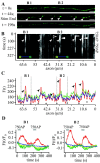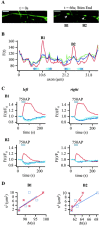Monitoring clathrin-mediated endocytosis during synaptic activity
- PMID: 14985443
- PMCID: PMC6730391
- DOI: 10.1523/JNEUROSCI.4080-03.2004
Monitoring clathrin-mediated endocytosis during synaptic activity
Abstract
To visualize clathrin redistribution during endocytosis in hippocampal boutons, we used a fusion protein of clathrin light chain with enhanced green fluorescent protein. Both high potassium and electric field stimulation lead after a stimulus-dependent delay to a transient increase of fluorescence in synapses, but a slight and transient decrease in adjacent axonal segments. We conclude that the rise and fall of the signal in boutons, with decay kinetics remarkably similar to previous estimates of the endocytic time course, reflects coat assembly and disassembly. Thus, we could selectively measure clathrin-mediated endocytosis and separate its kinetics from other modes of membrane retrieval in CNS synapses. A long-lasting delay preceding the fluorescent transients shows that endocytosis during the first few seconds of continuing stimulation cannot be mediated by newly formed clathrin-coated pits. Therefore, a fast mode of endocytosis is either clathrin-independent or involves preassembled (easily retrievable) clathrin lattices at sites of endocytosis.
Figures







Similar articles
-
Clathrin-mediated endocytosis is the dominant mechanism of vesicle retrieval at hippocampal synapses.Neuron. 2006 Sep 21;51(6):773-86. doi: 10.1016/j.neuron.2006.08.029. Neuron. 2006. PMID: 16982422
-
Constitutive endocytosis of GABAA receptors by an association with the adaptin AP2 complex modulates inhibitory synaptic currents in hippocampal neurons.J Neurosci. 2000 Nov 1;20(21):7972-7. doi: 10.1523/JNEUROSCI.20-21-07972.2000. J Neurosci. 2000. PMID: 11050117 Free PMC article.
-
Clathrin assembly lymphoid myeloid leukemia (CALM) protein: localization in endocytic-coated pits, interactions with clathrin, and the impact of overexpression on clathrin-mediated traffic.Mol Biol Cell. 1999 Aug;10(8):2687-702. doi: 10.1091/mbc.10.8.2687. Mol Biol Cell. 1999. PMID: 10436022 Free PMC article.
-
Clathrin-mediated endocytosis: the physiological mechanism of vesicle retrieval at hippocampal synapses.J Physiol. 2007 Dec 15;585(Pt 3):681-6. doi: 10.1113/jphysiol.2007.139022. Epub 2007 Jun 28. J Physiol. 2007. PMID: 17599959 Free PMC article. Review.
-
Understanding living clathrin-coated pits.Traffic. 2004 May;5(5):327-37. doi: 10.1111/j.1398-9219.2004.00187.x. Traffic. 2004. PMID: 15086782 Review.
Cited by
-
The Active and Periactive Zone Organization and the Functional Properties of Small and Large Synapses.Front Synaptic Neurosci. 2016 May 24;8:12. doi: 10.3389/fnsyn.2016.00012. eCollection 2016. Front Synaptic Neurosci. 2016. PMID: 27252645 Free PMC article.
-
Molecular basis of synaptic vesicle cargo recognition by the endocytic sorting adaptor stonin 2.J Cell Biol. 2007 Dec 31;179(7):1497-510. doi: 10.1083/jcb.200708107. J Cell Biol. 2007. PMID: 18166656 Free PMC article.
-
Calcyon is necessary for activity-dependent AMPA receptor internalization and LTD in CA1 neurons of hippocampus.Eur J Neurosci. 2009 Jan;29(1):42-54. doi: 10.1111/j.1460-9568.2008.06563.x. Eur J Neurosci. 2009. PMID: 19120439 Free PMC article.
-
Synaptic vesicles in rat hippocampal boutons recycle to different pools in a use-dependent fashion.J Physiol. 2006 May 1;572(Pt 3):707-20. doi: 10.1113/jphysiol.2005.100842. J Physiol. 2006. PMID: 16439431 Free PMC article.
-
The reserve pool of synaptic vesicles acts as a buffer for proteins involved in synaptic vesicle recycling.Proc Natl Acad Sci U S A. 2011 Oct 11;108(41):17183-8. doi: 10.1073/pnas.1112690108. Epub 2011 Sep 8. Proc Natl Acad Sci U S A. 2011. PMID: 21903923 Free PMC article.
References
-
- Aravanis AM, Pyle JL, Tsien RW (2003) Single synaptic vesicles fusing transiently and successively without loss of identity. Nature 423: 643-647. - PubMed
-
- Ashery U, Betz A, Xu T, Brose N, Rettig J (1999) An efficient method for infection of adrenal chromaffin cells using the Semliki-Forest virus gene expression system. Eur J Cell Biol 78: 525-532. - PubMed
-
- Blanpied TA, Scott DB, Ehlers MD (2002) Dynamics and regulation of clathrin coats at specialized endocytic zones of dendrites and spines. Neuron 36: 435-449. - PubMed
-
- Brodin L, Low P, Shupliakov O (2000) Sequential steps in clathrin-mediated synaptic vesicle endocytosis. Curr Opin Neurobiol 10: 312-320. - PubMed
-
- Brodsky FM, Chen CY, Knuehl C, Towler MC, Wakeham DE (2001) Biological basket weaving: formation and function of clathrin-coated vesicles. Annu Rev Cell Dev Biol 17: 517-568. - PubMed
Publication types
MeSH terms
Substances
LinkOut - more resources
Full Text Sources
Molecular Biology Databases
